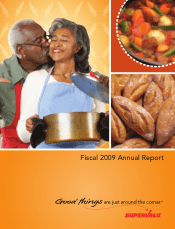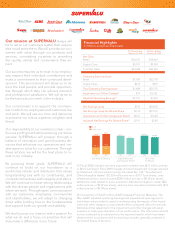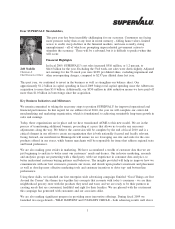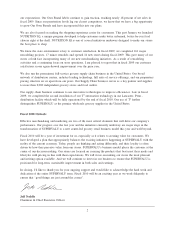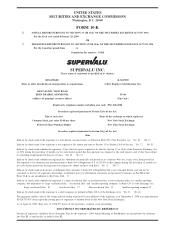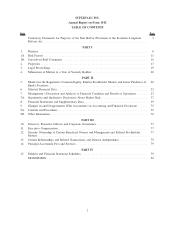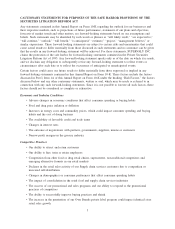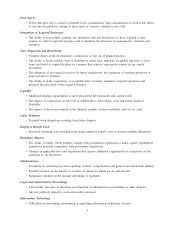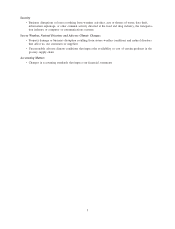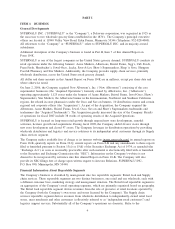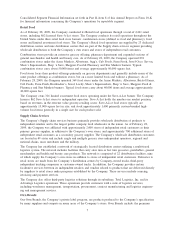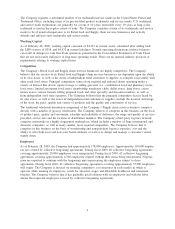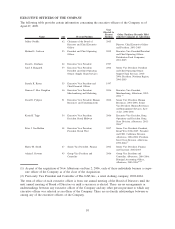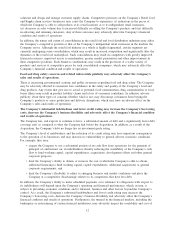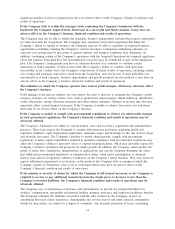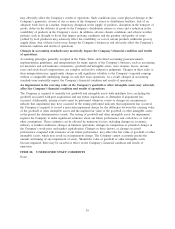Albertsons 2009 Annual Report Download - page 11
Download and view the complete annual report
Please find page 11 of the 2009 Albertsons annual report below. You can navigate through the pages in the report by either clicking on the pages listed below, or by using the keyword search tool below to find specific information within the annual report.Consolidated Segment Financial Information set forth in Part II, Item 8 of this Annual Report on Form 10-K
for financial information concerning the Company’s operations by reportable segment.
Retail Food
As of February 28, 2009, the Company conducted its Retail food operations through a total of 2,421 retail
stores, including 862 licensed Save-A-Lot stores. The Company conducts its retail operations throughout the
United States under three retail food store formats: combination stores (defined as food and pharmacy), food
stores and limited assortment food stores. The Company’s Retail food operations are supplied by 23 dedicated
distribution centers and nine distribution centers that are part of the Supply chain services segment providing
wholesale distribution to both the Company’s own stores and stores of independent retail customers.
Combination stores provide an extensive grocery offering, pharmacy department and expanded sections of
general merchandise and health and beauty care. As of February 28, 2009, the Company operated 874
combination stores under the Acme Markets, Albertsons, bigg’s, Cub Foods, Farm Fresh, Jewel-Osco, Sav-on,
Shaw’s Supermarkets, Shop ’n Save, Shoppers Food & Pharmacy and Star Markets banners. Typical
combination stores carry about 50,000 items and average approximately 60,000 square feet.
Food stores focus their product offerings primarily on grocery departments and generally include many of the
same product offerings as combination stores, but on a more limited basis and without a pharmacy. As of
February 28, 2009, the Company operated 369 food stores under the Acme Markets, Albertsons, Bristol Farms,
Cub Foods, Farm Fresh, Hornbacher’s, Jewel, Lucky, Shaw’s Supermarkets, Shop ’n Save, Shoppers Food &
Pharmacy and Star Markets banners. Typical food stores carry about 40,000 items and average approximately
40,000 square feet.
The Company owns 316 limited assortment food stores operating under the Save-A-Lot banner. The Company
licenses 862 Save-A-Lot stores to independent operators. Save-A-Lot holds the number one market position,
based on revenues, in the extreme value grocery-retailing sector. Save-A-Lot food stores typically are
approximately 15,000 square feet in size, and stock approximately 1,400 primarily custom-branded high-
volume food items generally in a single size for each product sold.
Supply Chain Services
The Company’s Supply chain services business primarily provides wholesale distribution of products to
independent retailers and is the largest public company food wholesaler in the nation. As of February 28,
2009, the Company was affiliated with approximately 2,000 stores of independent retail customers as their
primary grocery supplier, in addition to the Company’s own stores, and approximately 700 additional stores of
independent retail customers as a secondary grocery supplier. The Company’s wholesale distribution customers
are located in 49 states and include single and multiple grocery store independent operators, regional and
national chains, mass merchants and the military.
The Company has established a network of strategically located distribution centers utilizing a multi-tiered
logistics system. The network includes facilities that carry slow turn or fast turn groceries, perishables, general
merchandise and health and beauty care products. The network is comprised of 22 distribution facilities, nine
of which supply the Company’s own stores in addition to stores of independent retail customers. Deliveries to
retail stores are made from the Company’s distribution centers by Company-owned trucks, third-party
independent trucking companies or customer-owned trucks. In addition, the Company provides certain
facilitative services between its independent retailers and vendors related to products that are delivered directly
by suppliers to retail stores under programs established by the Company. These services include sourcing,
invoicing and payment services.
The Company also offers third-party logistics solutions through its subsidiary, Total Logistics, Inc. and its
Advantage Logistics operations. These operations provide customers with a suite of logistics services,
including warehouse management, transportation, procurement, contract manufacturing and logistics engineer-
ing and management services.
Own Brands
Our Own Brands, the Company’s private label program, are products produced to the Company’s specification
by many suppliers and compete in many areas of the Company’s stores. Own Brands include: the premium
7

